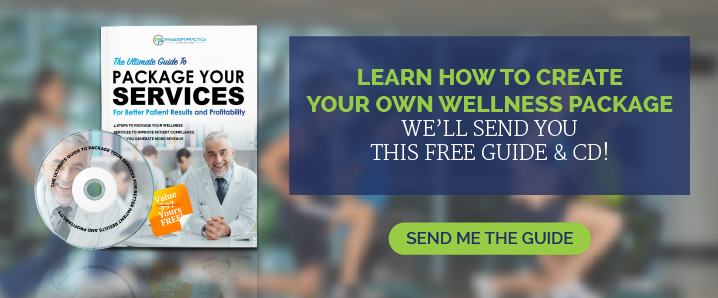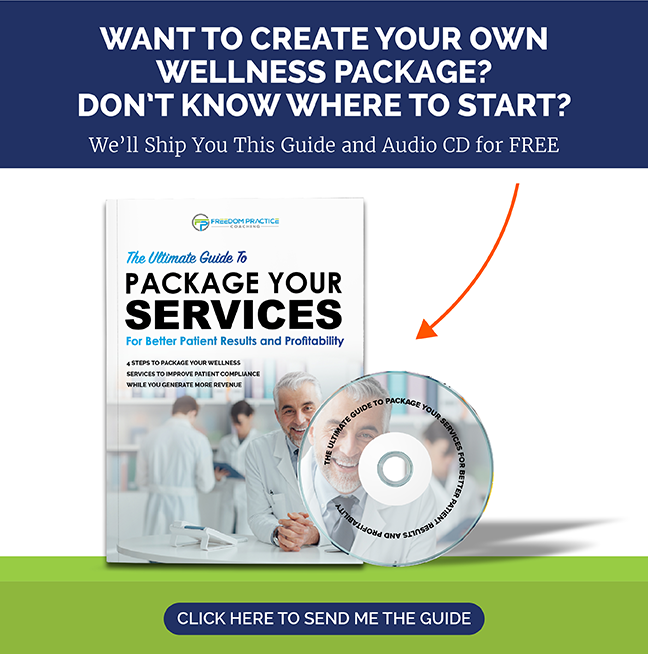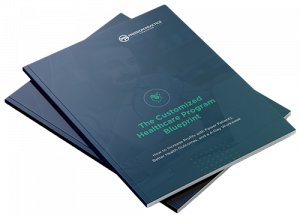Reason #1: You’re more in control of the patient’s care
When you Package Your Services You’re more in control of the patient’s care.
Let me paint a picture for you:
I want you to imagine your 3 favorite patients you’ve ever worked with. The ones that you wish every patient could be like. Think about WHY they were your favorite patients.
I imagine they came to you with a fairly serious health issue, you educated them, they were compliant, followed all of your advice, changed their health habits, followed your recommendations, and they worked with you over the length of time necessary to see huge health breakthroughs. These patients saw you as being the one who helped them, where others might have let them down.
That’s what made them your favorite patients.
The patients who were ‘less than ideal’ probably didn’t follow your recommendations entirely, made excuses as to why they couldn’t keep up with healthy daily habits, and likely ended their care when the majority of their symptoms subsided, rather than sticking through for long term resolution.
Now what if I told you that every single one of your patients could be very much like these top 3 all-time favorite patients?.
You may think that’s unrealistic, and it is if you choose to stay in the fee for service model. But, if you learn to package your services in a specific way that your patients can see the long term investment you’ll see that it is not only possible to have your practice full of ideal patients, but probable.
Let me explain.
The wellness package is designed to deliver the perfect patient experience while helping them to achieve an optimum level of health. A quick note. If your only goal is to simply address your patients’ current symptoms and then turn them loose, then this discussion will not be beneficial for your practice model. However, if you wish to guide them to breakthrough results and long-term resolution then listen up.
When a patient comes in for their first visit – You review their history, do your assessment, figure out what their big health goal is, and from that you determine:
- Can I help them?
- Are they willing to be compliant?
- Am I willing to accept their case?
- What additional diagnostics will be required?
- What extent of education will they need?
- What type of treatments, modalities and supplementation will they need?
- What is the expected length of treatment to resolve their challenges?
- What will be their total financial investment and what options do they have?
As you can see, by addressing all these questions you are forced to design a complete resolution and long term benefit rather than a temporary solution. Otherwise, why go through all of this effort?
By packaging your services, you are willing to be transparent with your patients in regards to what they can expect both in personal responsibility, time and financial investment, if they are to reach their goals. You, as the practitioner must act as the expert and the guide to fully communicate this to your patient before asking them to participate in your care and recommendations. Anything less is in my opinion is a loss of integrity and personal responsibility to your patients.
They have a right to know, up front, what goals can be reached, how exactly this is going to happen and what the exchange of value will be. It is not your job to pre-judge of whether this person is willing to apply themselves or whether they can afford your recommendations. Your job is to lay it out for them to decide.
They may have initially sought out your services for a quick fix, but that doesn’t mean you should simply lay down, be lazy and prescribe a quick fix.
They don’t know any better, but you do. They trust you to do your job and fully educate them about their options.
You will find that this model brings your patient in as a partner in health, that will assume personal responsibility and hold themselves accountable for the daily decisions they make regarding their health. This is completely different than the traditional models that tend to address symptoms with a general disregard to fully educate the patient as to why they are unhealthy and how they can play a critical role in reaching those breakthrough results.
In the packaging model, you are now fully in control of their care and you know that they’ll have everything they need to be successful.
In the fee-for-service model, patients have a buffet of choices that they feel that they can pick and choose from, allowing them to not follow all of your recommendations, and end up dropping off before they have a big health breakthroughs.
We all know that a 100% insurance model is even more limiting, where there are services that you know the patient needs that just aren’t covered. So rather than educate them on these necessary, but uncovered services, you might not even bring this up for discussion. Not good.
When you design packages specifically for patients, you get to call the shots, NOT The Insurance Companies, Not The Patient’s Changing Emotions from Week-To-Week. You determine what’s best for the patient, communicate that up front, let them know the role they have to play, and help to guide them all the way to the end of their health journey.
The clients we’ve worked with over the last several years, who’ve implemented this model, have shared that hands-down, the patients that they see now are more compliant, more proactive, and get much better results. In other words, all of their patients are now like their top 3 patients.
That’s the power of packaging your services.
Reason #2 – Higher patient compliance
When you Package Your Services in a specific way, patients tend to be much more compliant.
Let me break this down for you.
In a packaged model, you’re following a common sense approach that suggests that you take the time to truly understand why your prospective patient has sought out your services and advice. You’ve taken the time to have a conversation with them that leads to a complete understanding of what they see as the ultimate destination.
Remember, you must look past the symptoms and into how their life has been affected because of the underlying reasons they have their symptoms.
When they know you understand how their life is being affected and what they see as the perfect scenario- the dream life that they want to live, they will be open and ready to follow your recommendations.
You will likely be the first practitioner they’ve visited that lays out a complete plan to include everything they will need to be successful and take ownership of their health.
The overall benefits of the packaged model includes, ensuring your patient remains compliant through the recommended program. They’ve been fully educated on what to expect, they recognize they are to be a co-laborer in the process and they understand that you’ve put a competent plan together to secure the outcome. Basically an all-inclusive type of experience so they can enjoy the journey and not think about the money again. The last thing they want is to be nickeled and dimed every time they walk into your practice.
The main benefit is you’ve delivered a plan that logically makes sense and gives them hope that they will finally reach their destiny. No longer do they have to keep researching on the internet, playing a guessing game of what’s real and what’s not. They can break away from the constant stress of thinking about their concerns and get on with their life. Trust me, they see a tremendous value in this, and will gladly back this up by investing their own money into their health. Nothing will bring about higher compliance than when your patients’ have skin in the game.
Let me show you how having ‘skin in the game’ is a game-changer.
This is a part of the reason why other models fail. In a fee-for-service model, by design, the patient is not asked to commit fully to long-term care. They just commit to whatever the next step or recommendation is, until they choose to not commit.
Somewhere along the course of their care they might be thinking, ‘When am I going to reach my health goal? Where are we going with this?” They haven’t really invested that much, and they’re judging whether they should invest more based off of the results that they’ve gotten (or haven’t gotten) thus far.
You’ve probably experienced this, where some patients will start picking and choosing what services, what supplements, what tests they want. They make decisions based off of how much it costs, or how confident they are in that specific recommendation. You don’t want them doing that.
Stick to the fee-for-service model and continue to see patients drop off of care well ahead of your recommendations. The consequences… Less breakthrough results, an expense of time and money to your patient rather than an investment, less referrals, and burn-out for you and your team.
I’ve always taught my clients that they should see their services and treatments as the plane ride that gets them to their destination. The patient does not really care how you get them to Tahiti just as long as you get them there and they feel confident this will happen. They’re investing into Tahiti not the plane ride. The minute you place the value on the ride, they only see the value of the ride, which is much less than the destiny. The week in Tahiti is worth 7K, the plane ride only $1,200. Get the point.
This is not just ‘Theory’, an idea that we have that packaging works better, or that it gets better compliance. This is something that we’ve tested through working with 100’s of doctors. Our clients, across the board, share with us that the quality of patient that they work with now is much higher. Patients are more engaged, more compliant, and because of that they’re getting better results. They’re ready to take action and make changes in their lives.
By Packaging Your Services you will see higher patient compliance, but it’s not just something that is better for the patients, it’s a much better business model for you- the practice owner.
Reason #3 – Better Model for the practitioner
Why is packaging is a better model for you and your practice?
1. Better patient compliance.
We’ve just discussed how this is obviously best for the patient, but it serves you well in the fact that you will get better patient outcomes. Your reputation is based on it. Not only your reputation, but your sanity.
Imagine a practice in where you don’t have to call patients to remind them of their appointments, convince them to take your recommended supplements or recommended treatments. No longer do you have to place so much focus on getting new patients because most of your patients have stuck with you for the long-haul, gotten great results, and send tons of referrals.
2. Practice exactly the way you want.
Be honest here. Are you making recommendations based on what you truly feel is the optimum program for your patients, or, are you making recommendations based on CPT codes that pay better and protocols that you think will be easier for the patient to accept?
Packaging your services will allow you to practice with integrity and confidence. It allows you the opportunity to practice on your terms, not the insurance company’s and not your patient’s. Your patient is not the CEO of your company and therefore should not be telling you how to run your practice.
You are to listen to your patient and provide the absolute best recommended program and experience. But this doesn’t mean pamper to your patient’s wants in regards to what they think they need and to their convenient timelines.
I know practitioners that continue to open their practices on the weekend when the work week is nowhere close to being full. They justify this by stating this is the only time certain patients can make it in. Hogwash.
If you were their cardiologist I promise you they would schedule their appointment at the time slots you offered them. No whining or complaining. Why? Because they take you seriously and consider their cardiac health of extreme importance.
Do they consider your services and your time valuable? If not, perhaps it’s because you haven’t communicated your value in a manner in which they understand. You’ve trained them to think this way. Tough one to swallow, right?
3. Higher profit potential.
Your average patient is willing to invest much more on a complete package that is focused on the destiny than a handful of appointments that include particular treatment protocols and services directed toward symptom relief. With FPC clients we see an average of a 300% increase in the lifetime value of their patients when they convert to packaging. Much of this value can come from adding an educational curriculum to your package, which is something we strongly recommend…and provide to our FPC clients. Don’t believe for a second that your patients will benefit or see value in any education that is not structured, but simply delivered, in piecemeal fashion during their regular visits.
4. Higher quality of care to fewer patients.
I’m not suggesting you don’t try to help as many folks as you can, but first make certain you don’t sacrifice quality of care and patient experience for increased numbers. I’m not one who has any respect for the patient mill that tries to make up revenue numbers by accepting more patients than they can effectively handle.
When you offer packages, you will be getting much higher compliance and higher fees that allow you to focus on the right number of patients for your practice. Your focus should be to deliver the type of care you would deliver to your own family members.
This wraps up our summary on the 3 main benefits of packaging your services.
You will find that this model brings your patient in as a partner in health, that will assume personal responsibility and hold themselves accountable for the daily decisions they make regarding their health. This is completely different than the traditional models that tend to address symptoms with a general disregard to fully educate the patient as to why they are unhealthy and how they can play a critical role in reaching those breakthrough results.
To learn more about how you can transform your practice through the packaged service model, click the image below to grab your copy of “The Ultimate Guide To Package Your Services for Better Patient Results and Profitability” for FREE, today!






